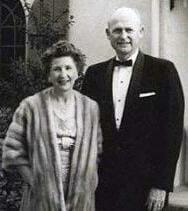 Robert and Adrienne Westerbeck lived in the same modest home in an unassuming neighborhood of Pasadena, California for over half a century. Never blessed with children, Robert was a retired engineer and Addie a retired music teacher until their deaths. They lived fairly quiet lives far past what many enjoy. Robert passed away at age 89 in 2006 and Addie at 103 just last year. But what people who knew them now marvel at is how the couple managed to amass an $8 million fortune to be given away upon their death to their alma maters.
Robert and Adrienne Westerbeck lived in the same modest home in an unassuming neighborhood of Pasadena, California for over half a century. Never blessed with children, Robert was a retired engineer and Addie a retired music teacher until their deaths. They lived fairly quiet lives far past what many enjoy. Robert passed away at age 89 in 2006 and Addie at 103 just last year. But what people who knew them now marvel at is how the couple managed to amass an $8 million fortune to be given away upon their death to their alma maters.
Robert Westerbeck, born in 1917, graduated in 1936 from what was then Pasadena Junior College (later to become Pasadena City College). He went on to work first for Lockheed Aircraft in Burbank and retired from another local engineering firm. Born in New York in 1906, as a child, Adrienne moved with her family from Colorado to California. She went on to earn several music degrees and then to teach music at Pasadena City College. It was there, when Bob decided to take piano classes in his middle-age years, that the two met and were forever linked from that day forward.
Between the two of them, they left all of their money to two colleges: $4 million to the Robert Westerbeck Scholarship Endowment and $4 million to the Adrienne Westerbeck Endowed Music Scholarship of the University of Southern California. Don Anderson, a board member of Pasadena City College said, “It’s like the story you hear about the little old lady who bought some forgotten stocks and dies a pauper, but then it turns out they were worth millions. I liken them to that.”
While Addie was said to have inherited a sizable amount about from her first husband over 50 years earlier, it was never obvious the two had much money. Legal papers left behind by the couple show they did invest wisely, but they never discussed their finances with others. As one friend put it, “They were very frugal. They came from a generation that didn’t showcase their wealth. They didn’t buy anything nor do anything major for themselves. When the heater in their home broke down, they didn’t replace it and lived pretty much in one room toward the end. That’s another reason we were surprised, because we felt they could have used some of that money on themselves in later years.”
What made this couple special in this age of quick fixes, greed, and economic alarm? Perhaps it was what a former associate to Robert Westerbeck noted; “They were the kind of quiet people who don’t get the credit. Just rock-solid, pillar-of-the-earth, doing whatever needs to be done and not looking for recognition.”
Perhaps being children of the Great Depression cast the mold that made people like Bob and Addie. Perhaps, because they never had children, they had no better place to spend it. But the odds are it was something more than either. Many Depression-era children were indeed frugal, but many also became just as turned in on themselves as the current generation. There are plenty of childless couples that build edifices that could house a small army.
Perhaps, instead, Bob and Addie Westerbeck just found something more important than money and things to fill their life together with. Whatever the reason, I am sure there are many other institutions that would be far better served by those who give willingly beyond themselves, than by government tax dollars attached to more strings than a bureaucrat can count.
“The life of a man consists not in seeing visions and in dreaming dreams, but in active charity and in willing service” – Henry Wadsworth Longfellow
“A bone to the dog is not charity. Charity is the bone shared with the dog, when you are just as hungry as the dog.” – Jack London
 Off The Grid News Better Ideas For Off The Grid Living
Off The Grid News Better Ideas For Off The Grid Living
